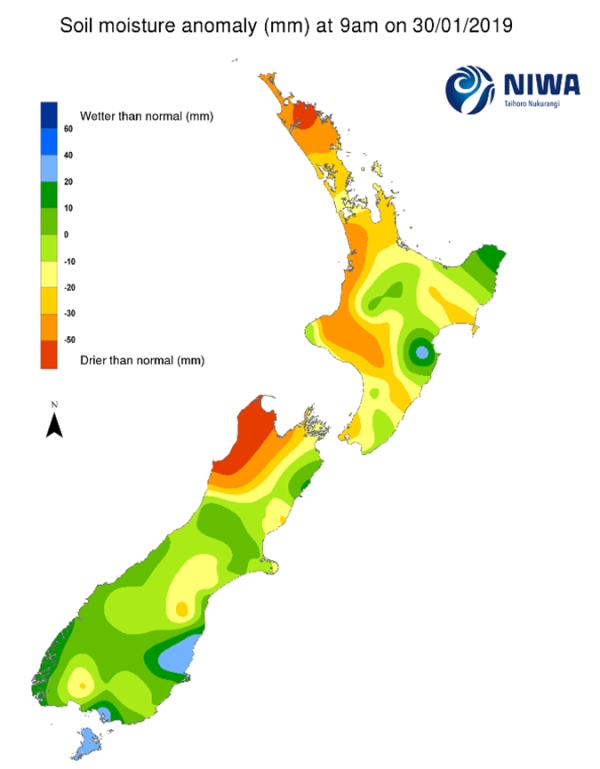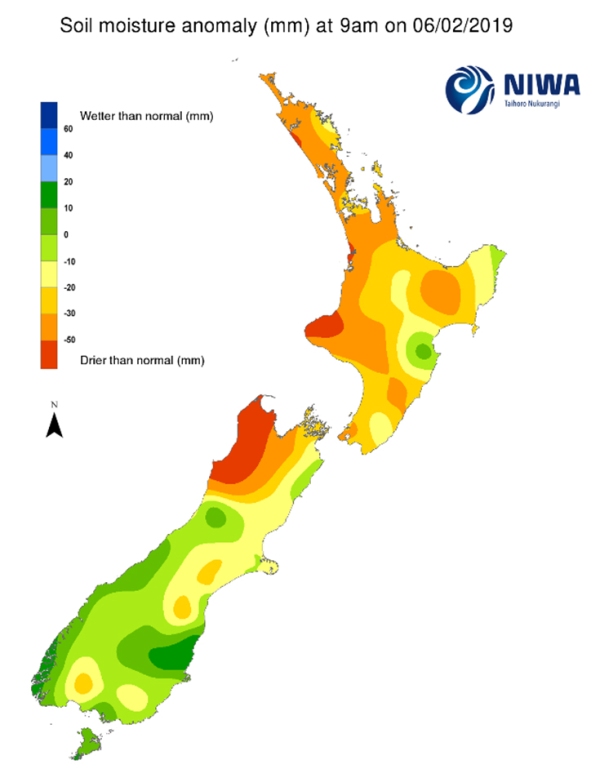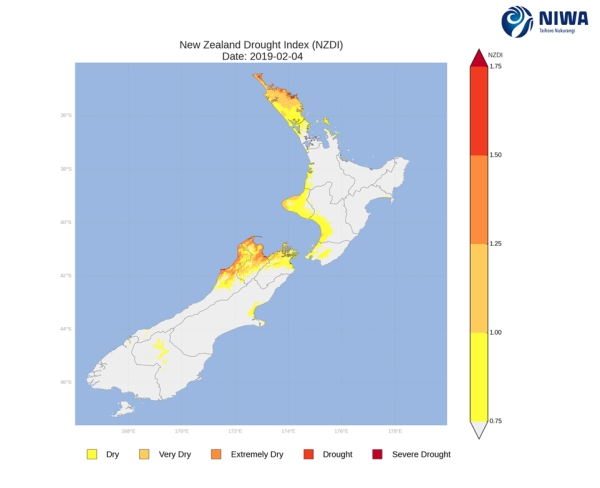A weekly update describing soil moisture across the country to help assess whether severely to extremely dry conditions are occurring or imminent. Regions experiencing these soil moisture deficits are deemed “hotspots”. Persistent hotspot regions have the potential to develop into drought.
Facts: soil moisture
Across the North Island, soil moisture levels decreased nearly everywhere during the past week. The only locations that saw slight increases were eastern Whangarei and eastern Far North districts. Soil moisture levels as of 7 February are below normal for the vast majority of the North Island, with the driest soil compared to normal for this time of year in the New Plymouth District, parts of western coastal Waikato and western Far North. The wettest soils for this time of the year are located in a portion of Hastings District where the soil moisture levels are near normal.
Areas deemed hotspots continued to expand during the past week in the North Island. A large hotspot now encompasses nearly all of Northland, Auckland, northern Waikato, and the Coromandel Peninsula. Additional hotspots are in place in coastal Taranaki, central and southern Manawatu-Whanganui, Wellington City and Porirua, northern Hawke’s Bay along with parts of Gisborne and Bay of Plenty.
Across the South Island, soil moisture levels decreased during the past week with meagre rainfall in the north and east. The driest soils across the South Island compared to normal for this time of the year are found in western Tasman and northern Buller District, while the wettest soils for this time of the year are found in north coastal Otago and coastal Fiordland.
The previous hotspot encompassing Nelson and portions of Tasman has continued to strengthen and expand during the past week. In addition, new hotspots have also developed in northern Marlborough along with small parts of Ashburton and Waimate districts in Canterbury.
Outlook and soil moisture
In the North Island, on Thursday and Friday (7-8 February) an easterly flow may deliver showers (5 mm or less) for eastern and northern areas. A low is forecast to drop south from the tropics but the current track will keep most of the rain offshore and east of NZ. However, northern and eastern areas may see a few showers through the weekend with more showers possible for Hawke’s Bay and Gisborne through Wednesday (14 February). Total weekly rainfall may exceed 30 mm in Gisborne and Hawke’s Bay with the potential for greater rain amounts in the ranges. Parts of the Coromandel and eastern Northland may see rain totals around 15 mm, while meagre rainfall generally below 10 mm is expected elsewhere. This will likely lead to an expansion of most hotspots across the island. The only exception may be the current hotspot in parts of northern Hawke’s Bay and southern Gisborne that will remain constant or slightly weaken over the next week.
For the South Island, light showers are expected along the West Coast on Friday and Saturday (8-9 February) bringing less than 10 mm to most locations. A front will move up the West Coast on Sunday (10 February) bringing up to 40 mm in places. Meanwhile, the upper West Coast, Tasman, and lower South Island will receive less than 15 mm from the same event. Tranquil weather is expected from Monday (13 February) through mid-next week with only isolated showers possible.
Total weekly rainfall may exceed 50 mm on the West Coast, 15 mm or less in the lower South Island and the Tasman Region, and little to any rainfall elsewhere. Due to the expected rainfall amounts all current hotspots will likely intensify and expand in the next week.
Background
Hotspot Watch a weekly advisory service for New Zealand media. It provides soil moisture and precipitation measurements around the country to help assess whether extremely dry conditions are imminent.
Soil moisture deficit: the amount of water needed to bring the soil moisture content back to field capacity, which is the maximum amount of water the soil can hold.
Soil moisture anomaly: the difference between the historical normal soil moisture deficit (or surplus) for a given time of year and actual soil moisture deficits.
Definitions: “Extremely” and “severely” dry soils are based on a combination of the current soil moisture status and the difference from normal soil moisture. See soil moisture maps for more information.
Hotspot: A hotspot is declared if soils are "severely drier than normal" which occurs when Soil Moisture Deficit (SMD) is less than -110 mm AND the soil moisture anomaly is less than -20 mm



